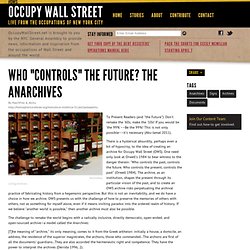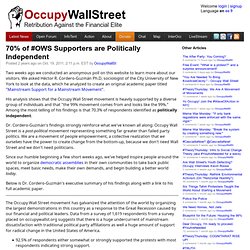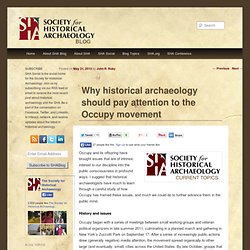

The Anatomy of the Occupy Wall Street Movement on Twitter. The Occupy Wall Street movement began in September 2011 as a grass roots protest against the inequality, greed and corruption associated with the financial sector of the economy.

The movement adopted the slogan: ”We are the 99%” which refers to the distribution of wealth in the US between the richest 1 per cent and the rest. What was extraordinary about this movement was the speed with which it spread, passing rapidly between communities via social media and Twitter in particular. So an interesting question is how this movement became so big, so quickly and what has happened since to the most active participants.
Today, we get an answer of sorts thanks to the work of Michael Conover and buddies at Indiana University in Bloomington. Who "Controls" the Future? The Anarchives. To Present Readers (and "the Future"): Don't remake the '60s; make the '10s!

If you would be 'the 99%'––Be the 99%! This is not only possible––it's necessary (Abu-Jamal 2011). There is a hysterical absurdity, perhaps even a bit of hypocrisy, to the idea of creating an archive for Occupy Wall Street (OWS). One need only look at Orwell's 1984 to bear witness to the danger therein: "Who controls the past, controls the future. Who controls the present, controls the past" (Orwell 1984). The challenge to remake the world begins with a radically inclusive, directly democratic, open-ended, and open-sourced archive—a model called the Anarchives: [T]he meaning of "archive," its only meaning, comes to it from the Greek arkheion: initially a house, a domicile, an address, the residence of the superior magistrates, the archons, those who commanded...The archons are first of all the documents' guardians...They are also accorded the hermeneutic right and competence.
Works Cited Abu-Jamal, Mumia. 2011. Knowledge to Empower the 99% Research Occupy, occupy the research. Occupyresearch - home. The greatest WordPress.com site in all the land! Academia Becomes Occupied With Occupy Movement. 70% of #OWS Supporters are Politically Independent. Posted 2 years ago on Oct. 19, 2011, 2:11 p.m.

EST by OccupyWallSt Two weeks ago we conducted an anonymous poll on this website to learn more about our visitors. We asked Héctor R. Cordero-Guzmán Ph.D, sociologist of the City University of New York to look at the data, which he analyzed to create an original academic paper titled "Mainstream Support for a Mainstream Movement". His analysis shows that the Occupy Wall Street movement is heavily supported by a diverse group of individuals and that "the 99% movement comes from and looks like the 99%. " Dr. Since our humble beginning a few short weeks ago, we've helped inspire people around the world to organize democratic assemblies in their own communities to take back public spaces, meet basic needs, make their own demands, and begin building a better world today. Below is Dr. In terms of demographic characteristics of the sample, we found that, Héctor R.
Full Paper: Mainstream Support for a Mainstream Movement (PDF) Occupy Wall Street Members' Income and Education Backgrounds Analyzed in Study. Ozier Muhammad/The New York TimesOccupy Wall Street protesters in Midtown Manhattan on May 1, 2012.

More than a third of the people who participated in Occupy Wall Street protests in New York lived in households with annual incomes of $100,000 or more, according to a study by sociologists at the City University of New York, and more than two-thirds had professional jobs. At the same time, the researchers found, nearly a third of the protesters had been laid off or lost a job, and a similar number said they had more than $1,000 in credit card or student loan debt.
Applied Research Center - New Study Offers Insights about Young Progressives' Views on Activism and Race. Wall Street Protesters Have Little Faith in Government (good report) Why historical archaeology should pay attention to the Occupy movement. Occupy and its offspring have brought issues that are of intrinsic interest to our discipline into the public consciousness in profound ways.

I suggest that historical archaeologists have much to learn through a careful study of how Occupy has framed these issues, and much we could do to further advance them in the public mind. History and issues Occupy began with a series of meetings between small working groups and veteran political organizers in late summer 2011, culminating in a planned march and gathering in New York’s Zuccotti Park on September 17. After a series of increasingly public actions drew (generally negative) media attention, the movement spread organically to other large (and eventually, small) cities across the United States. By late October, groups that took the Occupy label had spread around the globe–the German “Blockupy,” for instance.
Occupy has always been a big-tent movement, both in terms of its membership and of the issues its activists raise (Earle 2012).